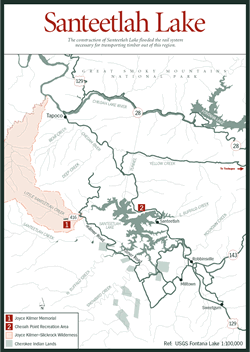 Santeetlah
Lake
Santeetlah
Lake  Santeetlah
Lake
Santeetlah
Lake [Fig. 39] In the midst of the lush, green mountain slopes, 3,000 acres of open water ideal for fishing, canoeing, and kayaking comprise Santeetlah Lake. (Its name is derived from an Indian word meaning "blue waters.") Santeetlah Lake is formed by the Santeetlah Dam across the Cheoah River on the northern end of the lake, and, like many of the man-made lakes in the mountains, Santeetlah makes its way into numerous picturesque coves and inlets. Most of the shoreline is undeveloped and part of the Nantahala National Forest, where ample camping opportunities abound. Cheoah Point [Fig. 39(2)], for example, can be reached 6 miles north of Robbinsville off US 129.
Both cold- and warm-water species of fish flourish here, including largemouth bass (Micropterus salmoides), smallmouth bass (M. dolomieui), walleye (Stizostedion vitreum), bluegill (Lepomis macrochirus), brown trout, and rainbow trout. Reports of osprey (Pandion haliaetus) and spotted sandpiper (Actitis macalaria) near the boating access area have been recorded in the spring and summer, and great horned owls (Bubo virginianus) have been spotted in the winter. During migration shorebirds and waterfowl including green herons (Butorides virescens), prothonotary warblers (Protonotaria citrea), and red crossbills (Loxia curvirostra) stop by the shallow coves of the many-fingered lake.
[Fig. 32(13), Fig. 40(3)] According to experts, settlement at the convergence of the Peachtree Creek and the Hiwassee River in Cherokee County dates back to the Archaic period (8000 to 1000 b.c.), with ongoing occupation continuing until historic times.
Unfortunately, an unscientific exploration of the village site and mound in 1885 resulted in the removal of significant archeological material. In 1933, however, the Smithsonian Institution conducted a more careful excavation of the site, which investigators concluded was the ancient Cherokee village of Guasili. Numerous recorders of Hernando De Soto's gold expedition to the area in 1540 mention Guasili, where they report they were graciously received and entertained. The Smithsonian team found nearly 250,000 pieces of pottery at the Peachtree Village site and discovered 68 burial sites, some enclosed in stone-lined graves.
Indians built earthen mounds that were often used as burial sites. The Peachtree Mound, according to the Smithsonian report, was a multilevel ceremonial structure. At the base, a hard-packed floor was the foundation for a wood and stone building, covered by a earthen mound about 60 feet in diameter. A sand strata separated the first mound from a larger mound which was built later and appeared to have undergone at least two major periods of construction. Evidence of superimposed floors indicated that the second mound supported three separate ceremonial structures.
[Fig. 32(14)] Earlier this century, settlement schools were established in the mountains of North Carolina as a means of bringing improved education to the isolated coves and valleys. Farming practices and craft instruction, for instance, were taught in an effort to elevate the depressed economies of the region.
The Campbell Folk School in Brasstown grew out of the efforts of John C. Campbell, his wife Olive Dame, and their friend Marguerite Butler. At the turn of the century, Campbell and his new bride studied mountain life from Georgia to West Virginia. While John interviewed farmers about their agricultural practices, Olive collected mountain ballads and studied regional handicrafts.
The Campbells were intrigued by an approach to education in Denmark that had helped transform the countryside into a vibrant and creative force: the folk school, or "school for life." It was their hope that this alternative to traditional education, when applied to the southern Appalachians, would help change the pattern that had developed that led intelligent young people away from their family farms to work in the cities. John died in 1919, but Olive Dame and Marguerite Butler continued to study folk schools in Denmark, Sweden, and other countries.
When they returned to America full of enthusiasm, these two dynamic women had the wisdom to know that the effective implementation of such plans had to grow out of a genuine collaboration with the people. While exploring several potential locations, Miss Butler made a trip to Brasstown, where she explained the idea to local merchant, Fred O. Scroggs. Before leaving, she told him she would be back in a few weeks to see if any interest had been shown. The 200 people who later greeted her at the local church offered a resounding "Yes!" They pledged labor, building materials, and other support, including 75 acres of land donated by the Scroggs family. In 1925, the Folk School began its work.
That work continues today, although its focus has shifted with the times. Now designated an Historical District by the National Register of Historic Places, the Folk School's 27 buildings are the scene of many services to the community, a variety of special events, and an internationally recognized crafts instruction program. The 372-acre campus features fully equipped craft studios where people from all over the world come to learn pottery, weaving, spinning, dyeing, blacksmithing, stained glass, basketry, wood carving, woodworking, broom making, dollmaking, quilting, and many other crafts. In addition to crafts, the Folk School has been instrumental in preserving mountain music and dance traditions. A sawmill, meeting rooms, covered outdoor dance pavilion, nature trail, craft shop, vegetable garden, and rustic lodgings are scattered across the picturesque campus. While many buildings are in the style of typical Appalachian farm buildings, some were designed by a Belgian architect in a Romantic European style, adding to the unique ambiance and quickly impressing on any first-time visitor that something special is going on here.
Campbell Folk School and other settlement schools in the area—Penland School of Crafts (see page 80) and Arrowmont School of Art & Craft in nearby Gatlinburg, Tennessee—were originally founded by urban social workers to teach country people city ways. Ironically, today these schools are in great demand to teach weary city dwellers the ways of these magnificent mountains.